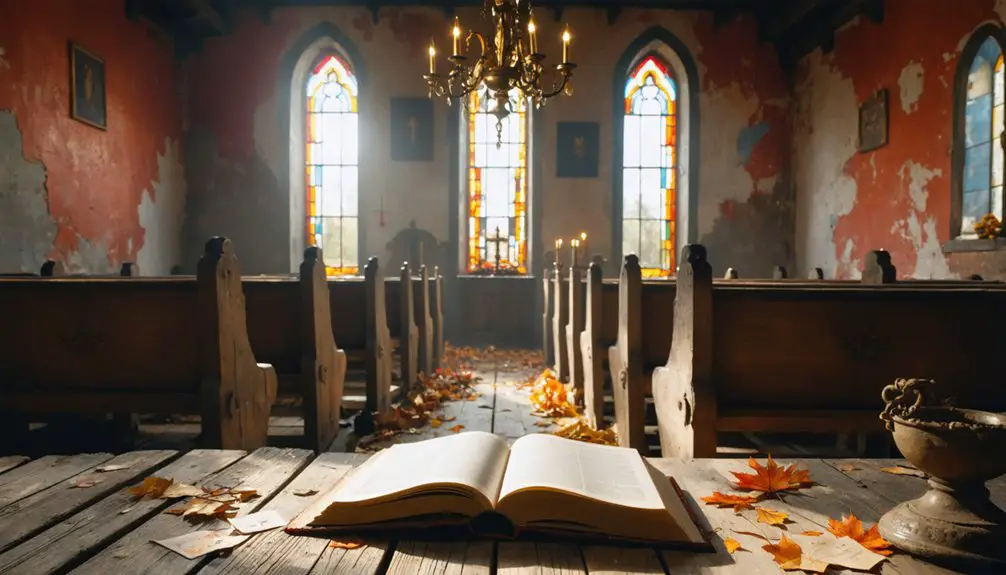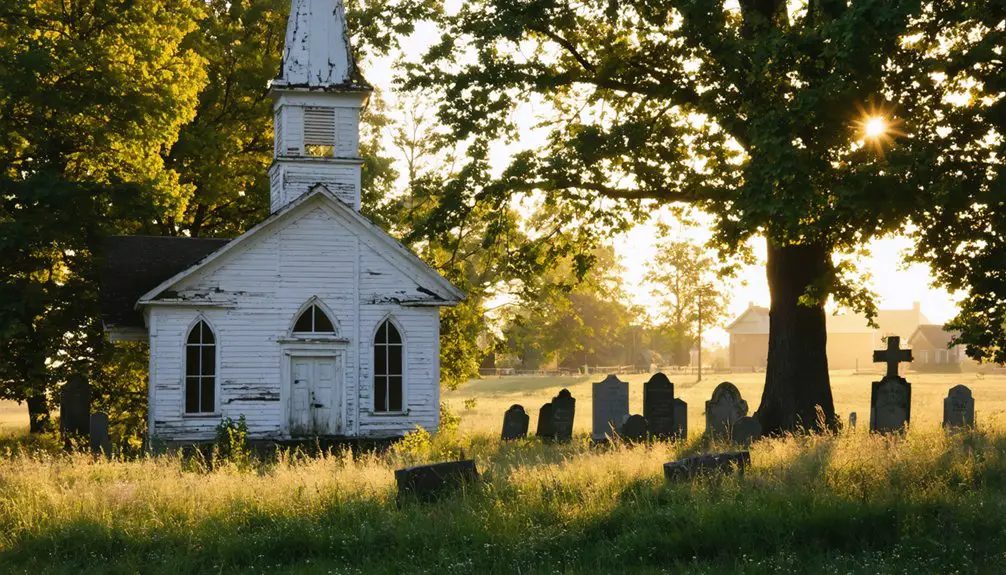You’ll find Isadore, Michigan, tucked away in Leelanau County, where red-brick Holy Rosary Church still stands sentinel over a once-vibrant Polish settlement. Founded in 1870, this farming community flourished until economic decline transformed it into a ghost town. The area gained notoriety in 1907 when Sister Mary Janina disappeared, her remains discovered a decade later in the church basement. Beyond the haunting ruins and abandoned farmhouses, Isadore’s landscape holds countless untold stories of immigrant dreams and dark secrets.
Key Takeaways
- Isadore was established by Polish immigrants in 1870 in Centerville Township, Michigan, and later became a ghost town due to economic decline.
- The historic Holy Rosary Church, built in 1882, remains a prominent landmark and testament to the Polish settlement’s Catholic heritage.
- The community gained notoriety from the 1907 disappearance of Sister Mary Janina, whose remains were discovered in the church basement.
- Numerous abandoned buildings, farmhouses, and barns dot the landscape, showing the remnants of a once-thriving agricultural community.
- The ghost town preserves Michigan’s rural history through its structural remains and occasional services at the original 1883 wooden church.
The Rise and Fall of a Polish Settlement
When Polish families first arrived in Michigan’s Centerville Township around 1870, they established a settlement that would become known as Isadore. Originally called Four Corners, this rural community embodied the immigrant struggles of peasants who’d fled German, Russian, and Austrian rule in their homeland.
Like many Polish immigrants of that era, they formed mutual aid societies to support each other through hardships and preserve their cultural traditions. Their Polish heritage reflected in how they built their lives around the Roman Catholic faith, culminating in the construction of Holy Rosary Church by 1882. The community’s children attended mass before school daily, reinforcing the strong connection between faith and education.
These determined settlers worked hard to evolve from unskilled laborers to landowners through the Homestead Act, distinguishing themselves from their urban counterparts in cities like Detroit and Chicago.
Through sheer determination and the Homestead Act, Polish immigrants transformed themselves from laborers into proud landowners, forging their rural American dream.
While Isadore flourished initially as an agricultural community, shifting economic patterns and the decline of farming lifestyles eventually led to its transformation into the ghost town you’d find today.
Dark History: The 1907 Holy Rosary Church Murder
While exploring Isadore’s Polish settlement history, you’ll encounter the haunting 1907 disappearance of Sister Mary Janina, a Felician Nun who served as Mother Superior at Holy Rosary Church.
Your journey through this dark chapter reveals how the nun’s skeleton wasn’t discovered until 1917, when Father Edward Podlaszewski found her remains hidden beneath lumber in the church basement.
A local investigation with search dogs and clairvoyants attempted to locate Sister Janina after her initial disappearance.
You’ll learn how the case ultimately led to a controversial confession from the rectory’s housekeeper Stella, who was later pardoned, leaving the true circumstances of Sister Janina’s death shrouded in mystery.
Her story gained national attention when actor Dick Van Dyke portrayed a priest in The Runner Stumbles, a 1979 film dramatizing the tragic events.
Murder Mystery Unfolds
In the summer of 1907, a chilling mystery gripped the small Polish settlement of Isadore, Michigan, when Sister Mary Janina vanished without a trace from the Holy Rosary Church.
Father Edward’s discovery of her remains in the church basement would eventually reveal she had likely been buried alive.
The community search intensified as locals combed the area, even bringing in bloodhounds and consulting a clairvoyant in their desperation to find answers.
Several mystery theories emerged, including whispers of a forbidden romance with the parish priest, though his alibi proved solid. The housekeeper’s false confession, obtained under pressure from investigators, only added to the confusion before she was later pardoned.
You’d have heard strange reports of ghostly singing drifting from the nearby swamp, adding to the settlement’s growing unease.
Little did the searchers know that the truth lay beneath their feet – Sister Janina’s body remained hidden in the church basement under a carefully placed pile of lumber, a dark secret that wouldn’t surface until 1917.
Sister’s Body Found Hidden
The dark secret of Sister Janina’s fate emerged in 1917, as plans to replace Isadore’s wooden Holy Rosary Church took shape.
You’d have found her hidden remains buried beneath a pile of wood in the basement, where they’d lain undisturbed for a decade since her 1907 disappearance.
Father Edward Podlaszewski led the grim investigation that revealed the truth townspeople had feared would surface during the new church’s construction.
While the community had once searched with bloodhounds and consulted clairvoyants, even following reports of mysterious singing from a nearby swamp, Sister Janina had been right there all along.
The discovery brought closure to years of wild theories and rumors, though it couldn’t erase the scandal that would forever mark this rural Michigan parish.
Stanislawa Lipczynska’s confession finally revealed the chilling details of the pregnant nun’s murder.
Standing Sentinel: Holy Rosary Church Today
If you’re driving along East Gatzke Road in Isadore today, you’ll find Holy Rosary Church‘s red brick walls and Munich-crafted stained glass windows standing proudly against the Michigan sky, built upon fieldstones hauled by local farmers nearly a century ago.
While the church’s architecture speaks to the dedication of Polish immigrants who established this spiritual center in 1883, its basement holds darker memories of Sister Mary Janina’s unsolved 1907 murder. The church’s six pairs of windows illuminate biblical scenes through Zettler Company glass, meticulously crafted in Munich.
Yet despite its haunting past, the historic church continues to serve as a cultural landmark, drawing visitors who appreciate both its architectural beauty and its role in Leelanau County’s rich heritage. The church still maintains its traditions with Latin Mass services conducted by Father Donald Libby.
Historic Architecture Remains
Standing proudly atop the intersection of East Gatzke and South Schomberg roads, Holy Rosary Church continues to serve as Isadore’s most prominent architectural landmark.
The 1923 brick structure, built on a foundation of locally-sourced fieldstones, showcases the community’s dedication to historic preservation and architectural significance.
You’ll find thirteen Munich-crafted stained glass windows that catch the sunlight, telling stories through their vibrant hues. The red brick exterior, a reflection of the Polish immigrants’ determination, replaced the original 1883 wooden structure.
Next door, you’ll spot the 1905 brick schoolhouse that operated until 1999, where Felician Sisters once taught generations of students.
Together, these buildings stand as silent witnesses to Isadore’s rich cultural heritage, their architectural elements preserving memories of a once-thriving rural community.
Dark Past Lives On
Within Holy Rosary Church’s storied walls lies a dark chapter that haunts the community to this day. In 1907, Sister Mary Janina vanished without a trace, only to be discovered eleven years later as a skeleton in the church’s basement.
You’ll find that locals still whisper about spiritual hauntings and unexplained phenomena surrounding the old church grounds.
Despite bloodhounds, clairvoyants, and extensive searches, the truth behind Sister Janina’s murder remains shrouded in mystery. The discovery sparked secret investigations by church officials, who worked to contain the scandal.
Today, community folklore keeps the story alive, though many residents remain hesitant to discuss “the tragedy” openly. The brick church, built in 1923 atop field stones hauled by parishioners, stands as both a monument to faith and a silent keeper of its darkest secrets.
Exploring the Abandoned Town
Today, exploring Isadore’s abandoned landscape reveals a haunting tableau of Michigan’s rural past. As you venture along South Schomberg and South French Roads, you’ll discover scattered ruins and deserted homesteads that whisper tales of local folklore. The ghost town sits at the intersection of roads, serving as a landmark for visitors exploring the area.
Desolate farmhouses and crumbling barns dot Isadore’s countryside, echoing with whispers of Michigan’s fading rural heritage.
The Holy Rosary Church stands sentinel over the ghost town, a weathered guardian of memories perched above the forgotten settlement.
Your journey through this abandoned landscape offers:
- Numerous vacant buildings in various states of decay, perfect for urban exploration photography
- The historic wooden church from 1883, still occasionally hosting services
- Miles of open fields dotted with structural remains between Schomberg Road and East Bodus Road
You’re free to wander these quiet streets where Polish immigrants once built their dreams, though the empty buildings serve as silent reminders of a community that time forgot.
Cultural Legacy of Polish Immigrants

The Polish immigrants who settled in Isadore left an indelible mark on Michigan’s cultural landscape through their faith, traditions, and communal spirit.
You’ll find their influence in the architectural legacy of Holy Rosary Church, where Munich stained glass windows and locally gathered fieldstones tell stories of cultural preservation and collective determination.
These settlers maintained their heritage through vibrant immigrant traditions, including religious festivals, Polish hymns, and patron saint celebrations.
They built aid societies and fraternal organizations that strengthened their cultural bonds while adapting to American life.
Through generations, they’ve preserved their language and customs in religious ceremonies and social gatherings.
Even as Isadore transformed into a ghost town, the Polish community’s commitment to cultural legacy endures in the region’s surviving churches, monuments, and family histories.
Ghost Towns of Leelanau County
Scattered across Leelanau County’s picturesque landscape, you’ll find several haunting ghost towns that tell stories of Michigan’s boom-and-bust past.
Your ghost town exploration will reveal everything from isolated barns to entire abandoned villages, with many now protected within Sleeping Bear Dunes National Lakeshore.
The county’s economic decline led to the emergence of these forgotten places, where you can discover:
- Crescent, a once-bustling logging community on North Manitou Island, now accessible by ferry
- Historic structures preserved by the National Park Service, offering glimpses into the region’s logging and farming heritage
- Former settlements like Isadore, which mirror the county’s pattern of prosperity and abandonment
Today, these ghost towns serve as both historical landmarks and evidence of the changing fortunes of rural Michigan communities.
Frequently Asked Questions
Are There Any Descendants of Original Isadore Settlers Still Living Nearby?
You’ll find descendants maintaining settler heritage through active community connections, with several Polish-American families still living nearby and participating in Holy Rosary Church activities and local farming traditions.
What Happened to the School Records From Isadore’s Parochial School?
You’ll find the school history split between multiple locations – the Diocese of Gaylord archives, Holy Rosary Centennial Committee, and Leelanau Historical Society all maintain pieces of record preservation from those years.
Is Paranormal Activity Reported Around the Holy Rosary Church?
You’ll find chilling paranormal sightings at Holy Rosary Church, where visitors report ghostly encounters in the basement where Sister Janina’s skeleton was found, and eerie singing echoes from the nearby swamp.
When Was the Last Burial Performed in Isadore’s Cemetery?
Based on burial records, the last confirmed interment in your cemetery’s history took place on July 23, 1937, when they laid William Cota to rest, three days after his death on July 20th.
Does the Church Still Hold Regular Services or Special Occasions?
You’ll find St. Isadore Church maintains active church attendance with regular Mass throughout the week and special services like Ash Wednesday. They follow a consistent service schedule including morning, noon, and evening options.
References
- https://99wfmk.com/murder-in-a-michigan-ghost-town/
- https://99wfmk.com/isadore-michigan-2018/
- https://www.leelanauticker.com/news/the-lost-villages-of-leelanau/
- https://leelanau.com/explore-leelanau-ghost-towns-with-the-leelanau-historical-museum/
- https://975now.com/isadoremichigan/
- https://glenarborsun.com/leelanaus-early-polish-settlements/
- https://polishheritagesociety.com/history
- https://therapidian.org/history-polish-immigrants-churches-and-aid-societies-westside
- https://en.wikipedia.org/wiki/Centerville_Township
- https://www.polishroots.org/Research/History/polish_settlers_grand_rapids?PageId=245


